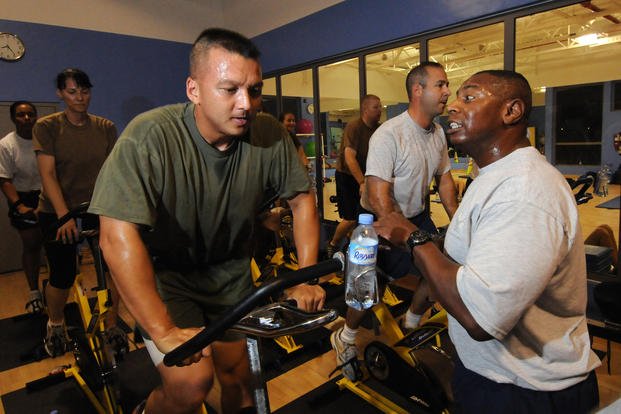Consistency wins when looking for results in any long-term goal or endeavor. Your effort each day, each week, each month, each quarter and each year is what yields results.
There is no pill that is going to do it. There are no shortcuts, tips, tricks or secrets that will get you to your goal when training for a specific program or meeting the fitness or weight standards required to join the military.
If the standards are high to get into a particular program, the training to get through that program may be even more rigorous. And if weight loss was easy, we would all be skinny. Fitness training and weight loss require discipline and consistent work if you want to see results.
The common denominator is time in the saddle. How much time are you putting into your training each day? This process does not have to start off with you spending hours of your day on fitness.
First, put a training time down on your schedule every day, because a workout period does not exist if it is not on your schedule. Second, go do it. You made time for it, so now it is a daily appointment you have with yourself. Taking time to do something for yourself is not selfish when that time enables you to be healthy for your family and prepares you to strive for greater challenges.
See below for easy and hard ways to become consistent with your training.
Walking. Walking is a perfect activity, especially if you do not do it already. Walking for 20 minutes a day is a great start. Over the course of a week, that is two or more hours of walking if you are consistent with it. If you put a little pep into your step and try walking faster than you normally do, you can add in more calories burned for the day; over the course of a week, you can burn up to 1,000 total calories if you are consistent with your 20-minute fast walks.
Add weight to walking. If you are 40 to 50 pounds overweight, there is no reason to add weight to your walk since you already are carrying added pounds that will help you burn more calories on each trip. You can burn more calories by rucking or hiking with a backpack if you choose, but do not jump into this type of training without a stronger core and legs and some strength training background. If you don't, you're likely to find that your back may not be ready for this level of exercise.
Strength training. Strength training can start with the basics. Calisthenics is a strength training exercise at first as you struggle to get your first push-up or pull-up. As your strength improves, calisthenics starts to evolve into an endurance exercise when you start aiming for your 50th push-up or 20th pull-up.
However, this evolution will not occur unless you are consistent with your training. Most people make a mistake when they do one or two things every day, only to burn out, build imbalances in their core and torso, and wind up injured.
Instead, divide your body in half. Work your upper body two or three days a week every other day, and the legs on the days in between. As calisthenics gets easy, you can start to add dumbbells or wear a weight vest and do the same movements with more weight but fewer repetitions.
Calisthenics testing. The military will test how many repetitions you can do in various calisthenics events (push-ups, crunches, plank pose, pull-ups). Eventually, your initial strength training has to evolve, and you must increase the volume of these exercises if you want to meet and exceed the standards for your branch of service.
The Classic Military Training Week is a model of how to fit these types of training programs into your day with consistency, balanced with a variety of exercises and recovery days so you do not burn out over time.
More difficult cardio options. As you become consistent with your walking and you find it getting easier, try adding a few running sets into your walking time. Maybe one of your days can be a fast run day where you go up and down a hill for a great challenge.
If the impact of walking and running is starting to hurt your feet, shins and legs, consider a nonimpact cardio option and use a bike, elliptical or rowing machine or go swimming. These are more challenging cardio options as you learn to increase speed, resistance and elevation, but they are nonimpact and don't put the same strain on your muscles and bones. Sometimes, consistent running or walking requires another option as the buildup into overuse injuries can occur if you're too aggressive at the start of this journey.
As you can see, some work is easier than other work, but consistency can take one day's activity and turn it into a week or a month's worth of activity. That's when you'll start to see results.
When you have a set time to start a physical activity, you also should set a time when it must be completed. This can help you say, "Only 30 minutes, I can do this." The time limit makes it easier to stick to it.
Also, if you want to make a time when there will be no interruptions, do it while others in your life or work are busy doing something else. Work out while your kids are in school or playing soccer, the family is sleeping or when everyone is eating lunch at work. Sometimes, you must get away from people and other distractions when making time for yourself, especially if you're trying to maintain consistency.
Stew Smith is a former Navy SEAL and fitness author certified as a Strength and Conditioning Specialist (CSCS) with the National Strength and Conditioning Association. Visit his Fitness eBook store if you're looking to start a workout program to create a healthy lifestyle. Send your fitness questions to stew@stewsmith.com.
Want to Learn More About Military Life?
Whether you're thinking of joining the military, looking for fitness and basic training tips, or keeping up with military life and benefits, Military.com has you covered. Subscribe to Military.com to have military news, updates and resources delivered directly to your inbox.



















